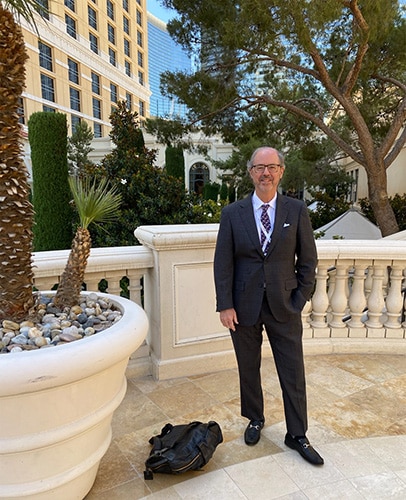
Facelift patients may not want to broadcast to the world that they’ve had work done, but as a plastic surgeon providing facelift procedures at the Chicago area’s Whole Beauty® Institute, Dr. John Q. Cook wants as many people as possible to know about the procedure.
More specifically, he wants other physicians to know about the facelift techniques he employs to improve safety, the patient experience, and the ultimate results.
That’s why he attended the multispecialty symposium—Vegas Cosmetic Surgery & Aesthetic Dermatology—as a featured speaker in June. Dr. Cook shared his approach to facelift techniques combined with fat transfer, using only local anesthesia, which is a procedure he has refined over two decades.
The annual event welcomes leading practitioners in four core specialties of aesthetics: facial plastic, oculoplastic, aesthetic dermatology, and plastic surgery. Dr. Cook noted that the symposium is “great for cross-pollination,” meaning medical providers can learn information outside of their typical channels in an effort to improve their own techniques and services.
Dr. Cook said it’s an honor to be featured again at the event, and his presentation was well received with many attendees asking questions afterward. The facelift technique he highlighted is a favorite of patients, to the point where it’s Whole Beauty® Institute’s No. 1 procedure. Dr. Cook estimates he performs two or three of the surgeries using local anesthesia each week.
The procedure is popular because of its results coupled with a much easier recovery. General anesthesia must clear from the body, which—while necessary for some procedures—can take days and have side effects like nausea and lethargy.
“Sometimes patients tell me the anesthesia recovery is worse than the surgical recovery,” Dr. Cook said.
If local anesthesia can be used—as is the case with Dr. Cook’s facelift techniques—the unpleasant side effects are minimized.
A key feature of this surgical technique is properly screening patients to ensure they are good candidates for the local anesthetic. Anyone considering this technique should be in good health—both physically and mentally. In other words, the patient should be someone who is totally fine with being awake during the procedure. For some people (maybe those who are uncomfortable going to the dentist), this may not be an attractive prospect, but for others, it can represent a radical new way of enjoying the benefits of a facelift. Some patients doze off anyway, while others chat with Dr. Cook.
“You don’t have a ‘dead zone’ in your life,” he explained, referencing the difference with general anesthesia. “It’s not this weird disruption to your normal consciousness.”
In early July, Dr. Cook saw a patient for follow-up who had recently undergone a third facelift with him—with each surgery spaced apart by about 10 to 12 years. Dr. Cook said this was her first under a local anesthetic. She had been having an easy recovery and said the experience was great.
Dr. Cook will next be speaking about facelift—as well as his structural technique for breast surgery and newer body contouring techniques—at a global conference in Miami in November.
For more information about facelift with local anesthesia (or any plastic surgery procedure), or to schedule a consultation, contact the Whole Beauty®Institute by calling 312-751-2112 (Chicago Gold Coast Office) or 847-446-7562 (North Shore (Winnetka) Office). You can also fill out an online contact form.

